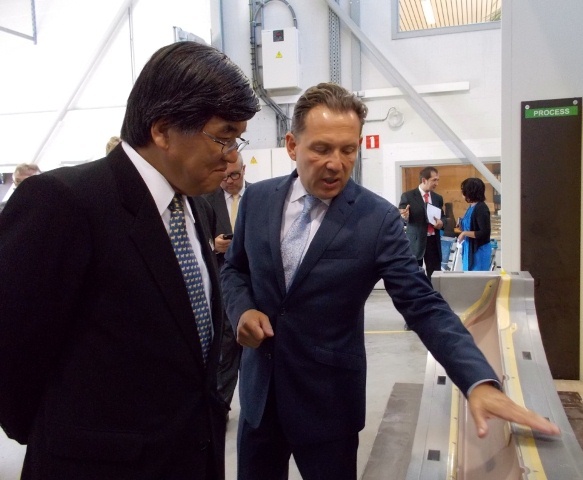Two Stories of Short-Lived Love(No.26)
More than 50 years ago, there was a beautiful daughter of the Japanese ambassador in Belgium who had just turned twenty. From time to time, she accompanied her father to parties of the diplomatic corps and helped welcome guests at dinners at the residence. As a result, her beauty became more and more known in social circles. On one occasion, she fell in love with a young Belgian doctoral student from a prestigious Belgian university and they started dating in secret. They had a good time together by takeing lunch or dinner intimately, going to the movies, etc. However, not long after they had started dating, the Japanese ambassador was summoned back to Japan. The daughter in question as well had to leave Belgium with her parents. Although the two were giving their hearts to each other, they parted forever without expressing decisive words from neither side. Time passed and this Belgian young man became a politician and rose to the post of Prime Minister at a young age. During his term in office as Prime Minister, he was invited by the Japanese government and visited Japan officially. He was granted an audience with the Emperor, but there was no reunion with the former Ambassador’s daughter. Now, I cannot know how he felt at the bottom of his heart in asking the Ambassador of Japan who is nearly 20 years younger than him “Do you have a daughter?”. Well then, this is a story of a “short-lived love” which exists everywhere and is a fleeting mid-summer night’s dream. In short, the story is a creation of my imagination. Please do not try to identify the person in the story.
< The 20th Anniversary of King Baudouin’s Death >
 On July 31st 2013, a mass to commemorate the late King Baudouin who passed away on this day in 1993 was held at the Saint Michel Cathedral in Brussels. King Baudouin ascended the throne as the fifth king in 1951 when he was 20 years old and reigned for 42 years. When the Belgians lost their beloved king unexpectedly at the age of 62 because of a heart failure, the entire country was immersed in deep sadness. Having worked as a young diplomat in Belgium from 1976 to 1978, I personally remember the stately appearance of the king. The memorial service was attended by former Queen Fabiola, King Philippe and Queen Mathilde, former King Albert II and Queen Paola and other members of the royal family. As a member of the diplomatic corps I also attended this 80-minute mass and remembered the days that have gone by. There was something tragic about King Baudouin, who lost his mother, former Queen Astrid, in a car accident before his fifth birthday and who himself ascended the throne against the background of his father’s, Leopold III, forced abdication due to accusations by the public of having had relations with the Nazis in World War II. Therefore, he was called the “King without a smile” at a certain time. I happened to meet one of the executives of the Baudouin Foundation on that same day and we talked about the old days. Solace could be drawn from the fact that this foundation, founded in 1976, continues various social activities, carrying out the will of King Baudouin. On July 31st 2013, a mass to commemorate the late King Baudouin who passed away on this day in 1993 was held at the Saint Michel Cathedral in Brussels. King Baudouin ascended the throne as the fifth king in 1951 when he was 20 years old and reigned for 42 years. When the Belgians lost their beloved king unexpectedly at the age of 62 because of a heart failure, the entire country was immersed in deep sadness. Having worked as a young diplomat in Belgium from 1976 to 1978, I personally remember the stately appearance of the king. The memorial service was attended by former Queen Fabiola, King Philippe and Queen Mathilde, former King Albert II and Queen Paola and other members of the royal family. As a member of the diplomatic corps I also attended this 80-minute mass and remembered the days that have gone by. There was something tragic about King Baudouin, who lost his mother, former Queen Astrid, in a car accident before his fifth birthday and who himself ascended the throne against the background of his father’s, Leopold III, forced abdication due to accusations by the public of having had relations with the Nazis in World War II. Therefore, he was called the “King without a smile” at a certain time. I happened to meet one of the executives of the Baudouin Foundation on that same day and we talked about the old days. Solace could be drawn from the fact that this foundation, founded in 1976, continues various social activities, carrying out the will of King Baudouin.
< Aalst and Mukogawa Women’s University >
 The other day, I paid a second visit to Aalst (29 km west of Brussels; 80.000 inhabitants) and met with Mr Christophe D’Haese, mayor of Aalst. The mayor is an N-VA politician and has been just appointed mayor since January this year, but he served before as the president of the municipal assembly for 6 years, so he has a very good knowledge of the local circumstances. Aalst is famous for its carnival held every year in early spring and the fancy-dress parade mocking current affairs is in the news in Belgium. According to the mayor, there are nearly 6000 participants in the parade and it is the tradition of the city that “Rain or shine, this festival goes on” (I am invited to this carnival next year on March 2nd). Also, there are two large hospitals specializing in cardiac disease in Aalst and celebrities suffering from heart disease come here for treatment, not only from Belgium but from all over the world. Even former King Albert II was once treated at one of these hospitals. To the Japanese, however, Aalst is known as the place where Honda Motor Co., Ltd opened the first overseas factory in 1962 (still operational as a packing centre for large components) (please refer to Ambassador’s Chat No. 5). When I left, the mayor asked me to sign the “Golden Note” (the Guest Book). Having a look at the Note, there was an entry of the “Mukogawa Women’s University Chorus Group” on the page of December last year. The university is located in Nishinomiya-city, Hyogo Prefecture in Japan and they visited Aalst with Prof. Tsutomu Mashiko, vocalist, as a leader of the group. I am surprised at the variety of exchanges between Belgium and Japan. The other day, I paid a second visit to Aalst (29 km west of Brussels; 80.000 inhabitants) and met with Mr Christophe D’Haese, mayor of Aalst. The mayor is an N-VA politician and has been just appointed mayor since January this year, but he served before as the president of the municipal assembly for 6 years, so he has a very good knowledge of the local circumstances. Aalst is famous for its carnival held every year in early spring and the fancy-dress parade mocking current affairs is in the news in Belgium. According to the mayor, there are nearly 6000 participants in the parade and it is the tradition of the city that “Rain or shine, this festival goes on” (I am invited to this carnival next year on March 2nd). Also, there are two large hospitals specializing in cardiac disease in Aalst and celebrities suffering from heart disease come here for treatment, not only from Belgium but from all over the world. Even former King Albert II was once treated at one of these hospitals. To the Japanese, however, Aalst is known as the place where Honda Motor Co., Ltd opened the first overseas factory in 1962 (still operational as a packing centre for large components) (please refer to Ambassador’s Chat No. 5). When I left, the mayor asked me to sign the “Golden Note” (the Guest Book). Having a look at the Note, there was an entry of the “Mukogawa Women’s University Chorus Group” on the page of December last year. The university is located in Nishinomiya-city, Hyogo Prefecture in Japan and they visited Aalst with Prof. Tsutomu Mashiko, vocalist, as a leader of the group. I am surprised at the variety of exchanges between Belgium and Japan.
< Two Company Visits >
 Last month, I paid a visit to one Belgian and one Japanese manufacturing company. I first visited “EcoPlast Technology” on the outskirts of Charleroi (60km south of Brussels), a small Belgian company with 45 employees and annual sales amounting to 7.5 million euro. Founded in 1985, the company has been developing for 28 years. They produce plastic parts such as car bumpers, which they export to countries around the world. Major car manufacturers such as Honda and Nissan are among their customers and they have developed a niche business, producing small amounts of high-quality parts for cars with particular specifications. President Bernard Gonsette gave me a tour of the factory, where plastic resin is poured into wooden moulds and all parts are carefully made one by one. I was surprised at the production process that is very much like a handicraft industry. There are not many companies like this one in the world and President Gonsette laughed that “there are no rival companies”. Last month, I paid a visit to one Belgian and one Japanese manufacturing company. I first visited “EcoPlast Technology” on the outskirts of Charleroi (60km south of Brussels), a small Belgian company with 45 employees and annual sales amounting to 7.5 million euro. Founded in 1985, the company has been developing for 28 years. They produce plastic parts such as car bumpers, which they export to countries around the world. Major car manufacturers such as Honda and Nissan are among their customers and they have developed a niche business, producing small amounts of high-quality parts for cars with particular specifications. President Bernard Gonsette gave me a tour of the factory, where plastic resin is poured into wooden moulds and all parts are carefully made one by one. I was surprised at the production process that is very much like a handicraft industry. There are not many companies like this one in the world and President Gonsette laughed that “there are no rival companies”.
 My next visit, end of last month, was to the factory of a Japanese company called “Nippon Shokubai Europe” on the outskirts of Antwerp. Its parent company, Nippon Shokubai, is a major company (founded in 1941; 3400 employees) in the chemical industry, having factories in Kawasaki-City and Himeji-City. The factory in Antwerp was founded in 1999 and is the only subsidiary in Europe. Nippon Shokubai Europe, currently employing 95 people (working day and night in 4 shifts, open all year round), produces annually 60.000 tons of a chemical product called superabsorbent polymer (SAP). Nippon Shokubai produces in total 560.000 tons of this product at its factories around the world, including Japan. They boast the world’s highest market share (more than 25%). The product is mainly used as a raw material in diapers and pet pads. At the beginning of the factory tour, I was shown an experiment with SAPs produced in the same factory. I was surprised at how just a tiny pinch of white fine powder absorbs in no time 1ℓ of water and turns into 1ℓ of white powder. I felt the wonder of chemicals when I heard that 10g of SAP is sufficient to make 1 disposable diaper. My next visit, end of last month, was to the factory of a Japanese company called “Nippon Shokubai Europe” on the outskirts of Antwerp. Its parent company, Nippon Shokubai, is a major company (founded in 1941; 3400 employees) in the chemical industry, having factories in Kawasaki-City and Himeji-City. The factory in Antwerp was founded in 1999 and is the only subsidiary in Europe. Nippon Shokubai Europe, currently employing 95 people (working day and night in 4 shifts, open all year round), produces annually 60.000 tons of a chemical product called superabsorbent polymer (SAP). Nippon Shokubai produces in total 560.000 tons of this product at its factories around the world, including Japan. They boast the world’s highest market share (more than 25%). The product is mainly used as a raw material in diapers and pet pads. At the beginning of the factory tour, I was shown an experiment with SAPs produced in the same factory. I was surprised at how just a tiny pinch of white fine powder absorbs in no time 1ℓ of water and turns into 1ℓ of white powder. I felt the wonder of chemicals when I heard that 10g of SAP is sufficient to make 1 disposable diaper.
< Misfortunes of the Belgian Royal Family >
Although the history of the Belgian Royal Family covers only a period of 182 years from 1831 onwards, the Royal Family encountered several unfortunate events during this period. The biggest misfortune was probably the accidental death of Albert I, the 3rd king, in the mountains in 1934. He fell to his death from a cliff while he was climbing in the neighbourhood of Dinant (70km south of Brussels) at the age of 58, too young. In World War I, he got angry with the German troops that wanted to invade France through Belgium and stated that “Belgium is not a road, but a country”. His strong convictions and resistance until the end made him a legendary figure among the Belgians, even now. Another event that grieved the Belgians was undoubtedly the death in a car accident of Queen Astrid (1935), wife of Leopold III, the 4th king of Belgium. Having a modest personality, she was loved and respected by the Belgian people. She married when she was 20 and became a mother of one daughter and two sons. Her life ended at the age of 29, so ephemeral. She was only Queen for one year, but her two sons would grow up to be both king and the firstborn of her second son became the 7th king the other day.
Tracing back the history of the Royal Family, one will find unfortunate events like in the movies or novels, such as the turbulent life of Princess Charlotte, Leopold I’s daughter, the death from illness of Crown Prince Leopold (10 years), son of Leopold II and the failure of the marriage of Princess Stephanie, daughter of Leopold II (it is closely related to “Short-Lived Love” (the story of Mayerling), the suicide pact of the Crown Prince of the Austro-Hungarian Empire that occurred at the end of the 19th century. Details will follow in my next Ambassador’s Chat). However, the biggest misfortune for the Royal Family was possibly the fact that the country was invaded twice, in World War I and II, by Germany, the first king’s birthplace. Queen Elisabeth, of German origin herself as well, was eagerly involved in nursing the sick and wounded soldiers in World War I and was therefore called the “Queen-Nurse”. In World War II, she developed activities to rescue Jewish children from the concentration camps. Then, after World War II, the actions of Leopold III taken during the war (Nazi-inclined) were seen as betrayal and caused a national uproar, which led to the King’s, partly forced, abdication in 1951. Even today, this “incident” seems to be burned in the back of the mind of elderly Belgians as an abominable event that could have almost caused a civil war in Belgium.
|